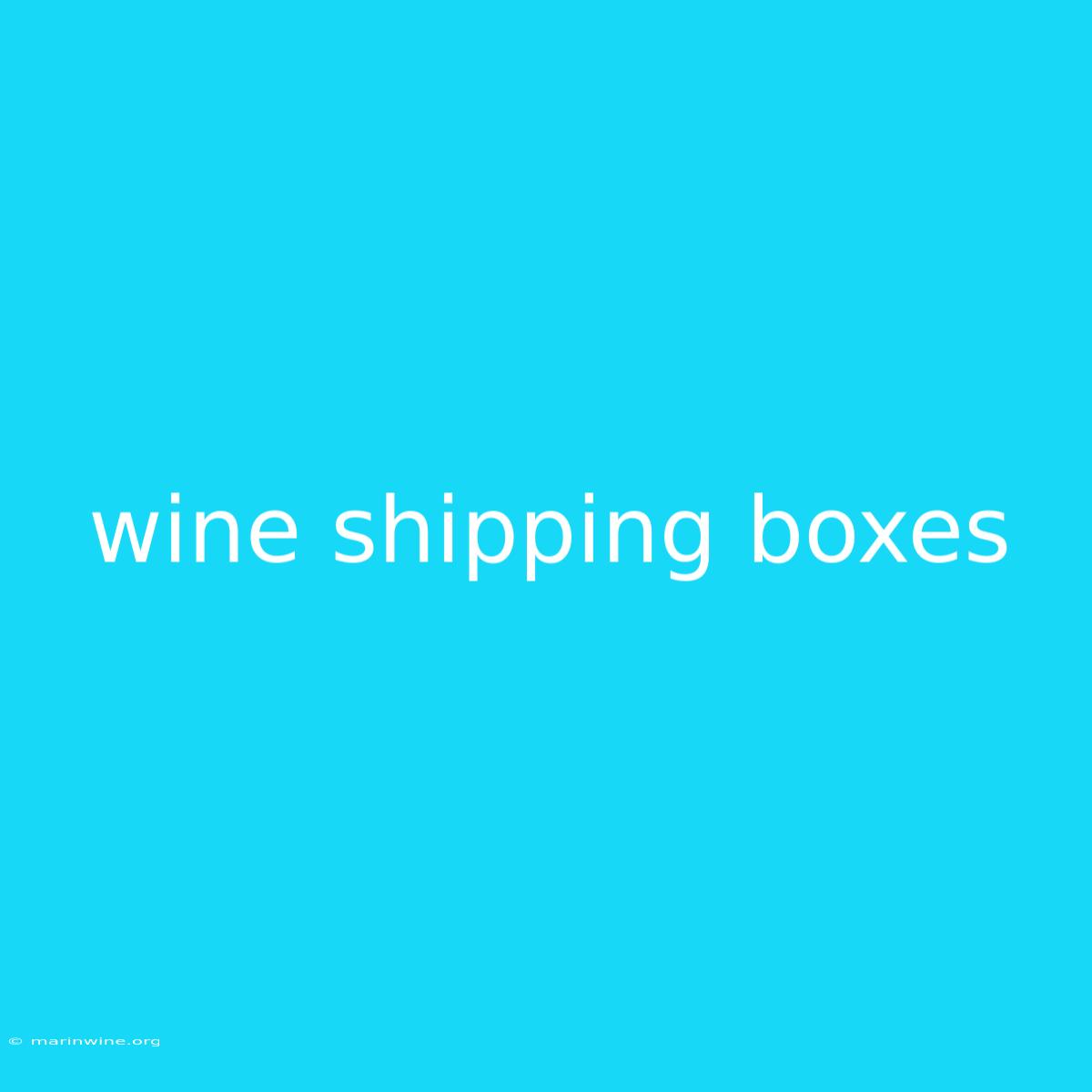Wine Shipping Boxes: The Perfect Way to Protect Your Precious Cargo
Have you ever wondered how wineries safely transport their delicate bottles of wine across vast distances? The answer lies in specialized wine shipping boxes, designed to withstand the rigors of shipping and ensure your precious bottles arrive in perfect condition.
Why It Matters
Shipping wine is a delicate process. Bottles are susceptible to damage from shock, vibration, and temperature fluctuations. This is where wine shipping boxes come into play, providing the necessary protection to ensure your wines arrive safe and sound. This article delves into the world of wine shipping boxes, exploring their design features and the importance of choosing the right box for your specific needs.
Key Takeaways of Wine Shipping Boxes
| Feature | Description |
|---|---|
| Protection Against Shock and Vibration | Specialized inserts and dividers prevent bottles from colliding and absorbing shock during transit. |
| Temperature Control | Insulated boxes help regulate temperature, protecting the wine from extreme heat or cold. |
| Secure Closure and Locking System | Secure closures and locking mechanisms prevent tampering and ensure the bottles remain safe throughout the journey. |
| Customizability | Boxes can be customized to fit different bottle sizes and shapes, ensuring a snug and secure fit for any type of wine. |
| Eco-Friendly Options | Sustainable and recyclable materials are becoming increasingly popular, minimizing the environmental impact of shipping. |
Wine Shipping Boxes: A Comprehensive Guide
Understanding the Importance of Packaging
Wine shipping boxes are not just ordinary cardboard boxes. They are carefully engineered to protect your valuable wine during shipping. The primary purpose of these boxes is to prevent damage from shock, vibration, and temperature changes. They also need to be sturdy enough to handle the rough handling that is inevitable during transit.
Key Aspects of Wine Shipping Boxes
-
Shock Absorption: Wine shipping boxes are designed to absorb shock and vibration. They use a variety of techniques to achieve this, including:
- Dividers: These are inserts that separate bottles and prevent them from colliding. They can be made of various materials, including cardboard, foam, or molded plastic.
- Padding: Cushioning materials, such as foam or air pillows, are placed around the bottles to further absorb shock and vibration.
-
Temperature Control: Wine is delicate and sensitive to temperature fluctuations. Shipping boxes can help to control temperature by using:
- Insulation: Specialized insulation materials can be incorporated into the box or around the bottles to help maintain a stable temperature.
- Temperature-Controlled Shipping: For shipments requiring precise temperature control, specialized carriers can be used.
-
Security and Tamper Resistance: Wine shipping boxes are designed to be tamper-resistant. This is essential to prevent theft and ensure that the wine remains untouched during shipping.
- Secure Closures: Boxes use strong, secure closures that can be sealed with tamper-evident tape.
- Locking Mechanisms: Some boxes also come with locking mechanisms that require a key to open.
Choosing the Right Wine Shipping Box
Selecting the right wine shipping box depends on several factors, including:
- The type of wine you are shipping: Some wines are more sensitive to temperature changes than others.
- The distance you are shipping: Longer distances require more protection.
- The number of bottles you are shipping: Boxes come in various sizes to accommodate different quantities.
- Your budget: Prices vary depending on the features and materials used.
It's important to choose a box that is properly sized and designed to provide adequate protection for your specific needs.
The Future of Wine Shipping Boxes
As the wine industry continues to grow, so too will the demand for safe and reliable shipping solutions. Here are some trends to watch:
- Sustainability: Increasingly, wineries and shipping companies are looking for more sustainable options. This includes using recycled materials and biodegradable packaging.
- Innovation: New technologies are being developed to provide even more protection and temperature control for wine shipments.
FAQ for Wine Shipping Boxes
Q: What is the best way to pack wine for shipping?
A: Carefully wrap each bottle in protective material, such as bubble wrap or packing peanuts. Then, place the bottles in a wine shipping box with dividers and padding to prevent damage during shipping.
Q: What are some tips for shipping wine safely?
A: Use a reputable shipping company and ensure that the box is properly labeled and addressed. If possible, ship during cooler weather. Avoid shipping during extreme temperature changes.
Q: What are some eco-friendly alternatives to traditional wine shipping boxes?
A: There are several eco-friendly options available, including boxes made from recycled materials and biodegradable packing materials.
Tips for Wine Shipping Boxes
- Use high-quality boxes: Invest in boxes designed specifically for wine shipping.
- Pack carefully: Use protective materials to cushion bottles.
- Label clearly: Use clear and legible labels for easy identification.
- Securely close: Ensure the box is securely sealed with tamper-evident tape.
- Ship with a reputable carrier: Choose a shipping company with experience shipping wine.
Summary of Wine Shipping Boxes
Wine shipping boxes are essential for safely transporting valuable wine. They are designed to protect bottles from damage, maintain proper temperature, and ensure tamper resistance. Choosing the right box for your specific needs is crucial to ensure your wines arrive in perfect condition. By investing in high-quality boxes and packing materials, you can protect your wine and ensure a safe and successful shipping experience.
Closing Message
The world of wine shipping boxes is constantly evolving, with new innovations and sustainability solutions emerging. As wine continues to be enjoyed worldwide, these boxes will play a crucial role in ensuring that every bottle reaches its destination safely and without compromising its quality.

